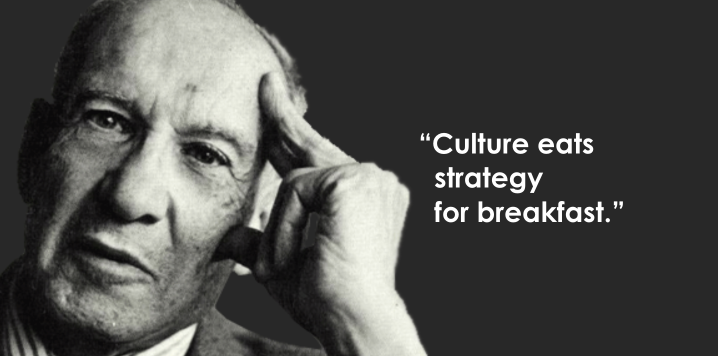Culture eats your structure for lunch
Gandhi Heryanto | Director at PT Citra Buana Prasidha
Peter Drucker famously said that culture eats strategy for breakfast. If strategy is for breakfast then your structure is for lunch. Culture will overcome any structural chart or any reorganisation.

Companies fail because they believe that a restructure will change the culture of the company. Even if a restructure creates temporary success, culture will reassert itself. Often senior managers ignoreorganisational culture because it works for them, by ignoring culture; the senior managers indicate that the organisation cannot learn because they engage in single loop learning. If senior managers cannot talk about culture, they are incapable of double loop learning. Culture refers to“the way we do things around here” , which means it requires double loop learning. Culture cannot be fixed by simply fixing mistakes. Culture is what creates the mistakes and it will always remain no matter the organisational chart or the structure chart. One of the main reasons why senior managers pursue restructures is that they believe that structure determines culture.
If structure determined culture, why would we talk about culture? The question captures the tension between culture and structure. What links them is organisational learning. A hierarchical learning organisation will behave differently than a matrix or decentralized organisation that cannot learn. What we find in organisations that can learn or have a learning culture is that teams and units work well because they can learn and adapt. As a result, they do not need to restructure. What they do need, though, is to be refreshed with new members or new responsibilities. However, the successful managers never confuse a restructure, a structural change, with double loop learning, a way of working. As complex entities, teams explore why they succeed and what needs to be changed to maintain that success. By contrast, most managers and most organisations focus on single loop learning so they turn to restructures in the hope that they will achieve double loop learning and changed ways of working. Successful managers look at ways of improving their teams and their units by building on their existing culture. The manager and the teams are both learning. They understand that maintaining a successful team requires adjustments and some change yet that change or outcome is not determined by the structure. If the structure is wrong, it is changed because the culture is working. The changed structure will not bring a new culture. As they realize the importance of culture within the team, and the wider culture of the organisation, successful managers reject the belief that minor adjustments within a team or teams can be scaled up to the whole organisation to achieve the result seen within the team. When managers and senior managers believe that minor changes in structures or teams can be scaled up to the organisation, they have forgotten culture. In the same way that those managers who are short sighted or simply without vision seek to restructure as an end in itself. In a dysfunctional organisation, senior managers start to restructure as a conscious strategy to avoid dealing with the corporate culture.
Restructuring to avoid dealing with a corporate culture When senior managers use restructures to avoid dealing with culture means that everything is in flux. Teams, units, and divisions are constantly working out their roles, responsibilities, and resources, with each restructure. Instead of creating a new culture to adapt, they only learn to adapt the existing culture to the new structure. As such, they are not doing double loop learning. Instead, they are using the restructure as single loop learning by adapting the existing culture to the new structure. Chief Executives, especially new ones, believe they have to stamp their authority on the organisation. Many do this by changing the structure to fit their vision. Often they choose a structure over culture because structure is concrete and easier to manage. Culture is harder to express than a structure on a single PowerPoint slide. However, successful CEOs will know that they will need to work with the culture to ensure their restructure succeeds. Experienced senior managers know that changing a culture will have a greater impact than any change to the organisational chart or roles and responsibilities, which means the two aspects need to work together.
Does your structure reflect your culture? In a learning organisation, the answer is yes. The reason why it will be a yes is that the managers are asking questions and challenging the organisation on a regular basis. When managers claim to have a decentralized and empowering culture often referred to as tight/loose, but the structure is hierarchical and centralized, you can see a gap. When senior managers claim they empower front-line staff, but give money and resources based on the hierarchy, the language does not match the reality. What we see is that the managers have stopped asking questions about the effectiveness of their culture. The structural problems reflect the cultural problems.
Restructuring is a way to solve many problems except for culture. Restructuring is popular because companies can find it difficult to talk about culture. It can also be difficult for an organisation to know itself. Instead, managers talk about their strategy, their structure, or even their values, such as being customer centred, but will find it difficult to articulate, described or even speak about their culture. Culture is messy. It gets back to identity and engagement neither of which is easy for a manager to do. Yet, culture is what creates an engaged employee willing to do more for the company. A company’s culture is more than a list of values, yet many companies will point to a list of values and say “That is our culture.” If that is how you understand your culture you will not be able to change it because you do not know what it is. Culture is made up of the myths, stories, and accepted practices that infuse an organisation and explain the way we do things around here. For many managers culture is a challenge because they take it for granted. “It is what it is, so why change it”. For others it is resistant to change because of tradition, inertia, and habit of ways of working that require too much effort to change so it is best to work with it. “You are never going to change it, so why try?” In truly dysfunctional organisations, the Chief Executive or senior managers make their peace with the organisation and begin the slow, but certain, process of becoming institutionalised. “It’s not perfect but we are getting improvement so if it aint broke don’t fix it.” When that occurs, especially after a restructure, the organisation has exhaled. It can now breath again after the uncertainty of the restructure. The senior managers reach a new equilibrium and a culture change is avoided. The senior managers settle for what is working and do not seek to push the organisation to improve. They stop asking the questions about the culture, challenging the myths that hold the company back and just look happy to get along with the organisation.
Culture is messy; Structures are tangible We can see why senior managers want to avoid the culture discussion, or avoid trying to understand the way we do things around here, by focusing on structure and strategy. Senior managers can busy themselves with meeting after meeting discussing the strategy, or the structure, without examining or understanding how things are done. When an organisation cannot talk about its culture but is sure of strategy and its structure, it sees restructure as the solution. The management team will solve the problem it knows. However, each subsequent restructure fails to achieve the required results so more restructures are needed. The restructure cycle begins, but never embeds because it does not address the culture. The cycle unfolds in the following stages. The first stage, we see the management team arrive bringing the solutions searching for a problem. They scan the organisation and take stock of teams and talents. They then decide that a restructure is needed. The next stage emerges, which is the post-restructure period. As the teams and units are pushed into uncertainty, some respond and others continue to lag. Overall performance improves as individuals and teams seek to benefit from the changes. They believe the new ways of working will lead to a change in culture. After a few years, the culture has not been addressed, except in a superficial way, the third stage emerges. In this stage, culture reasserts itself. There has been some change and some improvement, but the underlying organisational culture remains. In a sense, the organisation cannot learn which creates its blindness to the need to change culture. The next restructure is done, and the cycle continues. Once restructuring becomes an end in itself, has management stopped?
Speeding up the restructure cycle will not change the culture. We may continue to restructure and find an initial benefit as people seek new ways of working to adjust to the change in structure. Yet, that too will slowly, or quickly, unravels because the organisation, like its culture, is just waiting to exhale. The changes will be absorbed and the organisation will return to the way it has always worked. More and more restructuring will not change the culture because the restructure does not address the issue.
What needs to be done? An organisation and its managers need to be able to talk about how things are done. For example, if an organisation claims to be customer focused, putting the customer at the heart of everything it does, why does it have such high numbers of complaints? The managers have to look at the culture and the systems they have created. They need to look why their intended outcomes are not being achieved. What is also needed is a willingness to hear bad news and find a way to discuss it. If the organisation cannot find a way to discuss bad news, it cannot address its culture. An organisation may survive a long time with single loop learning and restructuring, but it will face a reckoning point where it has to change its culture or collapse. When you face your next restructure, ask yourself; is it to avoid dealing with the culture or because it reflects a learning culture?
